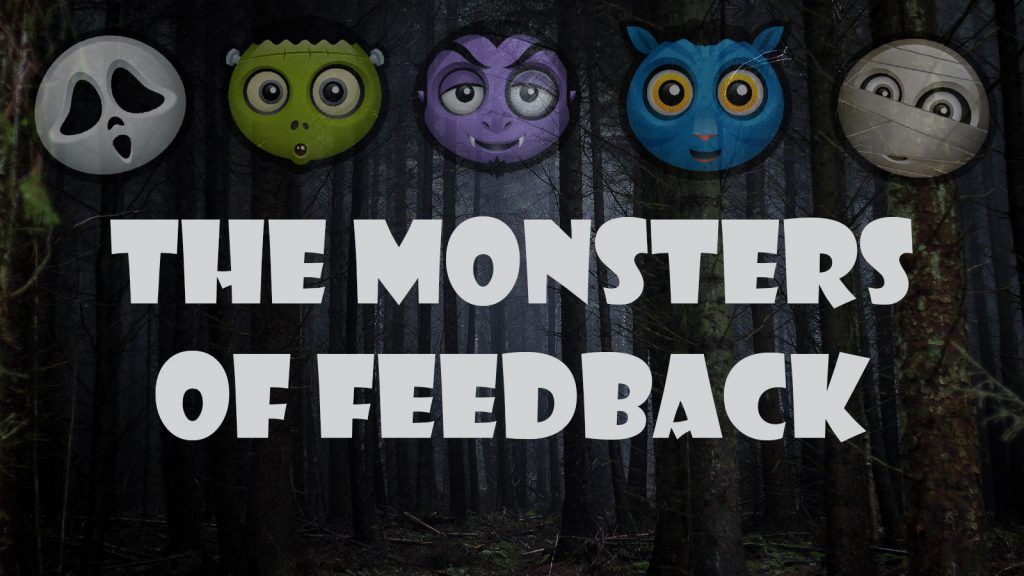The Monsters of Feedback

Halloween is approaching – ghouls, ghosts, and haunts of every kind are near. Yet, lurking in many schools throughout the year are other monsters: the monsters of bad feedback.
Be on the lookout for the following creeps, critters, and frights to ensure your school is not haunted by bad feedback.
The Ghost

The present does not matter to the ghost, nor does the future. The ghost is firmly footed in the past. Instead of providing feedback opportunities that promote growth, the ghost lingers around what has happened in the past. Ghosts cough up old conversations or old observations. They hover over old methods or outdated practices. They seek to get their hands on the teacher and transport them back into the past.
Rid your school of the ghost by ensuring feedback is about the future, about what comes next, and about growing student learning environments that let students flourish tomorrow, next month, and in the years ahead.
The Vampire

The vampire in a school is not of the typical blood-sucking variety. Instead, the school vampire is an energy-sucker. Vampires make feedback sessions feel like bloodletting through a variety of tactics. They may drone on and on, rehash every single piece of evidence collected during the observation, or offer up suggestion after suggestion for improvement. No matter how they do it, vampires suck away a teacher’s time and energy. And they do it by being the one talking – and talking – and talking.
Say goodbye to those energy vampires by offering feedback that is quick, providing data that is specific and to the point, and giving up control of feedback conversations. After presenting data, become the listener, and let the teacher drive the conversation while you guide through active listening.
The Mummy

What do we know about mummies? They are all dried up and ancient. Feedback mummies wait until days, weeks, or months after they have collected data to have a conversation. Their untimely conversations mean the evidence was collected way too long ago to be useful in any manner. The data is all shriveled and dry.
Get rid of the curse of the mummy by setting up feedback conversations on any piece of data entered or evidence collected within 24 hours of the collection. This keeps the conversation fresh, meaningful, and useful.
The Invisible Administrator
Despite what the name might suggest, the invisible administrator is easy to spot haunting a school; their absence speaks volumes. They do not provide any feedback after data collection – worse yet, they may not even conduct observations. They may be completely invisible as an instructional leader. Teachers who work with invisible administrators may not have a good sense of the culture or expectations of the school. It could also leave teachers feeling that observations have little to do with instructional improvement.
Scare away the invisible administrator by visiting classrooms, conducting observations, and providing feedback on any and all data collected in a timely manner.
Frankenstein

Frankenstein’s monster is greatly misunderstood. He tried his best; he meant to do good – but his size and heavy-handedness scared people, not to mention his lack of communication skills outside of grunts and groans. The traits of this feedback monster are much the same. The Frankensteins of feedback want to give feedback and try their best to do so. But something about the feedback unsettles teachers. Maybe it’s the amount of feedback provided. Maybe it’s the heavy-handedness with which they approach giving feedback. Maybe it’s the inability to communicate naturally. Whatever it is, teachers do not want to engage in the feedback process.
Rewrite the Frankenstein story by taking a lighter approach to feedback. Be conversational, approachable, and adaptable. It’s more important to make small and light changes over time. Those small changes are produced through much lighter conversations that allow you to avoid a heavy-handed approach.
The Werewolf

The werewolf turns from human into monster at the snap of the fingers. And when it turns, watch out. Werewolves are all over the place without a plan of action. They sprint from one talking point to another. They make huge jumps and leaps about what might be happening. They bring chaos to the conversation, and then when they don’t get their way, they may howl loudly. A frightful creature indeed.
Keep the werewolves at bay with planning and preparation. Before every feedback conversation, map out the important points you want to have as part of the conversation: the data collected, the objective measures, and the way you transition the conversation into active listening on your part.
These monsters haunt your ability to develop feedback conversations that promote growth. Be wary, and get those ghouls out of your school! To assist with turning monstrous feedback into effective feedback, review the NEE Guide to Effective Feedback Conversations.
Tom Hairston is the Managing Director of the Network for Educator Effectiveness. Tom has worked with NEE since 2011. Prior to his work with NEE, he worked for two years as a Positive Behavioral Interventions & Supports Consultant for the Heart of Missouri Regional Professional Development Center at the University of Missouri. He began his career in education as a high school special education and language arts teacher and football coach at Moberly High School in Moberly, Mo. Tom received his PhD in Educational Leadership and Policy Analysis from the University of Missouri in 2012.
The Network for Educator Effectiveness (NEE) is a simple yet powerful comprehensive system for educator evaluation that helps educators grow, students learn, and schools improve. Developed by preK-12 practitioners and experts at the University of Missouri, NEE brings together classroom observation, student feedback, teacher curriculum planning, and professional development as measures of effectiveness in a secure online portal designed to promote educator growth and development.


